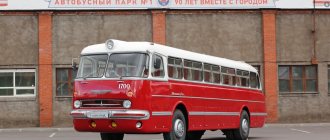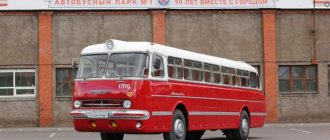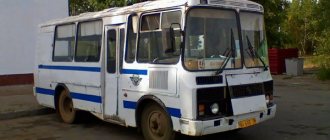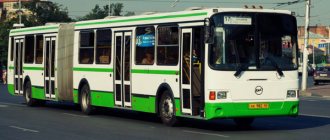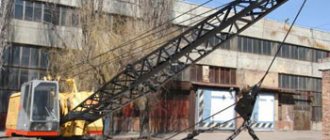Bus LAZ-697M Tourist. Photo Wikipedia
LAZ-697 “Tourist” is a Soviet middle-class tourist bus produced by the Lviv Bus Plant. The bus was intended for short intercity lines, excursion trips, and use on special express lines. LAZ-697 was unified with the LAZ-695 city bus.
History of creation
In the fall of 1958, the Lvov Automobile Plant produced a prototype bus designed for intercity transport. Because. that the car was planned to be used for long-distance transportation, he received an addition to the license plate number - “Tourist”. The new bus was a joint product of the automobile plant's engineers and designers from the NAMI Institute.
In addition to the fact that the Tourist received a number of design changes that distinguished it from the prototype (LAZ-695), the designers tried to create a comfortable environment for passengers.
The screen doors located at both ends of the cabin were replaced with one single-leaf door that opens manually. The roof of the car was made retractable.
Two systems were responsible for the microclimate in the cabin:
- heating type;
- forced ventilation equipped with an air humidifier.
Modification of LAZ-697 - LAZ-697M. Photo Wikipedia
The salon was designed for 33 seats . The passenger seat had a fairly comfortable design, with the ability to adjust the backrest angle. In addition, each place was equipped with : an individual night lighting lamp, a grid intended for books, newspapers or magazines, and an ashtray.
A separate additional chair was provided for the guide - 34th, with the ability to rotate 180 degrees.
It was this Lviv bus that was first marked with the ZIL brand name - the letter “L” in a chrome frame. Later, this sign began to designate all subsequent models and modifications of machines produced by the plant.
The finished prototype model was presented at the exhibition of national economic achievements, in a new category - “Intercity buses”.
At the beginning of the summer of 1959, LAZ created another version of the “Tourist” , under the same marking number, but which had a number of design differences from the first prototype.
Serious changes affected the roof of the bus : its sliding model was replaced by a huge hatch (1.8 x 2.7 m), which reduced the glazing area of the roof slopes. For the first time on this model, an air intake was installed above the windshields, which provided natural ventilation of the cabin. It was shaped like the visor of a cap. All subsequent buses were equipped with such a visor, which became a distinctive feature of LAZ vehicles. Also, the legacy of all subsequent bus models was the increased size of the windows, first installed on the LAZ-697 double.
Space for passengers' luggage was equipped directly under the cabin floor. Luggage was loaded from the outside, through special side hatches located on the sides of the bus.
The power unit was a ZIL-164 engine . Spring-type suspension (4 semi-elliptical springs) with springs for correction. This Lviv bus was presented as an exhibit at international exhibitions for 2 years in a row: in 1959 in France, and in 1960 in Switzerland.
Mass-produced cars differed from prototypes in their power unit. The 109-horsepower ZIL-158A engine was installed on intercity buses. The city ones also received the same engine - LAZ-695B.
Excerpt characterizing LAZ-697
“Ah, ma bonne, ma bonne, [Ah, darling, darling.],” he said, standing up and taking her by both hands. He sighed and added: “Le sort de mon fils est en vos mains.” Decidez, ma bonne, ma chere, ma douee Marieie qui j'ai toujours aimee, comme ma fille. [The fate of my son is in your hands. Decide, my dear, my dear, my gentle Marie, whom I have always loved like a daughter.] He walked away. A real tear appeared in his eyes. “Fr... fr...” Prince Nikolai Andreich snorted. - The prince, on behalf of his pupil... son, makes a proposition to you. Do you want or not to be the wife of Prince Anatoly Kuragin? You say yes or no! - he shouted, - and then I reserve the right to say my opinion. Yes, my opinion and only my opinion,” added Prince Nikolai Andreich, turning to Prince Vasily and responding to his pleading expression. - Yes or no? – My desire, mon pere, is never to leave you, never to separate my life from yours. “I don’t want to get married,” she said decisively, looking with her beautiful eyes at Prince Vasily and her father. - Nonsense, nonsense! Nonsense, nonsense, nonsense! - Prince Nikolai Andreich shouted, frowning, took his daughter by the hand, bent her to him and did not kiss her, but only bending his forehead to her forehead, touched her and squeezed the hand he was holding so much that she winced and screamed. Prince Vasily stood up. – Ma chere, je vous dirai, que c'est un moment que je n'oublrai jamais, jamais; mais, ma bonne, est ce que vous ne nous donnerez pas un peu d'esperance de toucher ce coeur si bon, si genereux. Dites, que peut etre... L'avenir est si grand. Dites: peut etre. [My dear, I will tell you that I will never forget this moment, but, my dearest, give us at least a small hope of being able to touch this heart, so kind and generous. Say: maybe... The future is so great. Say: maybe.] - Prince, what I said is everything that is in my heart. I thank you for the honor, but I will never be your son's wife. - Well, it’s over, my dear. Very glad to see you, very glad to see you. Come to yourself, princess, come,” said the old prince. “I’m very, very glad to see you,” he repeated, hugging Prince Vasily. “My calling is different,” Princess Marya thought to herself, my calling is to be happy with another happiness, the happiness of love and self-sacrifice. And no matter what it costs me, I will make poor Ame happy. She loves him so passionately. She repents so passionately. I will do everything to arrange her marriage with him. If he is not rich, I will give her money, I will ask my father, I will ask Andrey. I will be so happy when she becomes his wife. She is so unhappy, a stranger, lonely, without help! And my God, how passionately she loves, if she could forget herself like that. Maybe I would have done the same!...” thought Princess Marya.
Modifications
LAZ-697E. Since 1961, LAZ began supplying the new ZIL-130 engine with a power of 150 hp. They began to be equipped with both urban and intercity models; the corresponding modifications were named LAZ-695E and LAZ-697E. The maximum speed of the new buses has increased by 7 km/h. Until 1963, new engines were supplied to LAZ in small batches, so in parallel the production of the old LAZ-697 bus and the new LAZ-697E was carried out, and both modifications were identical in appearance.
LAZ-697M. Photo Wikipedia
From the beginning of 1964, deliveries of ZIL-130 engines became regular, which made it possible to abandon the modification with the old engine. Also at this time, the appearance of the LAZ-697E bus changed somewhat - the wheel arches acquired a round shape, and the flowing moldings on the body disappeared. The LAZ-697E bus was produced until 1969.
LAZ-697M. In 1970, production of the next modification of the LAZ-697M began, unified with the corresponding LAZ-695M city bus. The new bus differed from the previous one in a slightly different upper part of the body with enlarged side windows, the absence of glazing on the roof slopes and the absence of an air intake pipe at the rear - air intake for the engine was now carried out through the side deflectors. The bus also received power steering and a Hungarian “Raba” rear axle, which the previous modification did not have.
The first demonstration bus LAZ-697M was shown at an exhibition in Moscow in 1969 and it differed from the serial ones by a different design of the front end and emergency opening exits in place of some side windows. This bus was then demonstrated several times at various exhibitions until the end of production of the entire LAZ-697M series. LAZ-697M buses were produced serially until 1975, and you can always distinguish them by the large letter “L” on the front end. At the end of production of the LAZ-697M, a transitional model was produced in which the front part of the bus was retained from the LAZ-697M, and the rear part of the body corresponded to the LAZ-697N.
LAZ-697N. The first prototypes of the LAZ-697N “Tourist” bus were seen at the USSR Exhibition of Economic Achievements in 1971. In fact, this bus was a kind of hybrid from the then serial LAZ-697M body with a new front end. It is interesting that the prototypes of the LAZ-697N appeared somewhat later than the prototypes of the LAZ-695N and LAZ-699N, but it was put into mass production earlier than these buses, already in 1975. The production of the LAZ-697N in a “classic” form with a completely new body did not last long, less than three years.
In 1978, LAZ began production of a transitional model, which was also called LAZ-697N, but in many elements it was already unified with the future LAZ-697R model. For example, the side windows of the bus lost their vents - the body was now ventilated through a single air intake on the roof of the bus. These cars also have a second entrance door in the rear overhang, like its older brother LAZ-699N.
LAZ-697R. Production of the LAZ-697R bus began in 1978. The bus differed from the previous modification only in minor design changes. Externally, these buses can be distinguished from the LAZ-697N by the location of the front direction indicators - on the LAZ-697N they were round and located on the sides of the headlights, on the LAZ-697R the direction indicators were square and located above the headlights. Also on LAZ-697R buses they abandoned the rear door - an innovation used on the latest batches of LAZ-697N, since the presence of an additional entrance door on such a short bus greatly reduced passenger capacity.
Production of LAZ-697R buses continued until 1985, when it was finally discontinued in favor of the more spacious LAZ-699R model. Therefore, currently LAZ-697 buses are a rather rare model. The most common modification is the LAZ-697R, although in some parts of Ukraine the LAZ-697N and even the LAZ-697M are still operating. It should be noted that in the 90s, some LAZ-695N buses underwent local modifications, during which automatic doors were replaced with manual ones, and intercity-type seats were installed in the cabin. These cars can be distinguished from real LAZ-697R by the absence of an air intake on the roof and the presence of a second door in the rear overhang.
Technical characteristics of LAZ-697 "Tourist" '1958–85
LAZ-697 “Tourist” is a Soviet middle-class tourist bus produced by the Lviv Bus Plant. The bus was intended for short intercity lines, excursion trips, and use on special express lines. LAZ-697 was unified with the LAZ-695 city bus.
The bus had a number of modifications produced from 1959 to 1985:
LAZ-697 “Tourist” (1959-1963) - had a ZIL-164 engine with a power of 109 hp.
LAZ-697E “Tourist” (1961-1969) - with a ZIL-130 engine of 150 hp. The result of the changes was an increase in the maximum speed of buses to 87 km/h. However, the supplied batches of new engines were small, so along with modified models, the plant continued to produce “old” buses. Externally, the “old” and “new” cars did not differ from each other. This continued until 1964, when Zilov deliveries of power units became regular, and the new engine completely replaced the old model.
LAZ-697M "Tourist" (1970-1975) - modernization of the bus, a transitional version to the LAZ-697N bus, the main difference is a new body with high side windows, but with the old front panel of the body. Changes also affected the car's transmission. The factory rear axle was replaced with a more advanced one - “Slave”, made in Hungary, and the steering was equipped with a hydraulic booster. In 1974, the body was modernized (rear side part, new air ducts into the engine and the latest side windows) for the transition to the LAZ-697N model.
LAZ-697N "Tourist" (1975-1979) - a bus with a new front panel of the body. Since 1977, it has received new lighting devices corresponding to the UNECE. Prototypes appeared back in the late 60s. Also, for the XXV Congress of the CPSU, a batch of “Lux” buses, distinguished by increased comfort, was built to serve the delegates of the congress.
LAZ-697R “Tourist” (1978-1982), (1985) is the latest modification of the medium-sized intercity bus of the 697 family. Traditionally, the new bus differed only slightly from the old one. The most striking difference between the LAZ-697R and the LAZ-697N was the absence of a rear entrance door; it was again decided to abandon it, due to the fact that its presence reduced the number of seats. Well, another sign by which one could distinguish the new model from the old one is the location of the turn signals. The LAZ-697R's direction indicators had a more modern square shape and were located directly above the headlights. The LAZ-697N had turn signals located on the side of the headlights and had a round shape. It was distinguished by its interior ventilation system. The windows lost their vents, and instead of them an air intake appeared on the roof; in addition, the bus was distinguished by a reinforced body and its increased anti-corrosion resistance.
The production of the family of medium-sized intercity buses of the 697 series was discontinued in 1982, in favor of expanding the production of the large intercity bus of the LAZ-699 family, which was distinguished by a large number of seats (41, instead of 33 for the LAZ-697R). In 1985, for the future XXVII Congress of the CPSU, the plant built a small one-time batch of “luxury” buses of this family.
The engine of the LAZ-697 was located at the rear. The suspension had correction springs operating in parallel with the springs. The seats were double with an adjustable backrest angle. The bus capacity was 33 people. There were luggage compartments under the cabin floor. A separate additional chair was provided for the guide - 34th, with the ability to rotate 180 degrees.
All modifications of the 697 series buses belonged to the middle class, and time did not stand still. We needed a car with a lot of seats. Therefore, in 1985, production of the old “Tourists” was completely discontinued. They were replaced by the new 41-seater LAZ-699, sending the 697th series into the “retro buses” category
Engine/powertrain characteristics
- Model. ZIL-158A.
- Type. Carburetor.
- Engine power, kW (hp)/min. 80 (109).
- Engine location. Rear.
- Checkpoint. Mechanical, 5-speed.
- Suspension. The suspension had correction springs operating in parallel with the springs.
- Maximum speed, km/h. 80.




